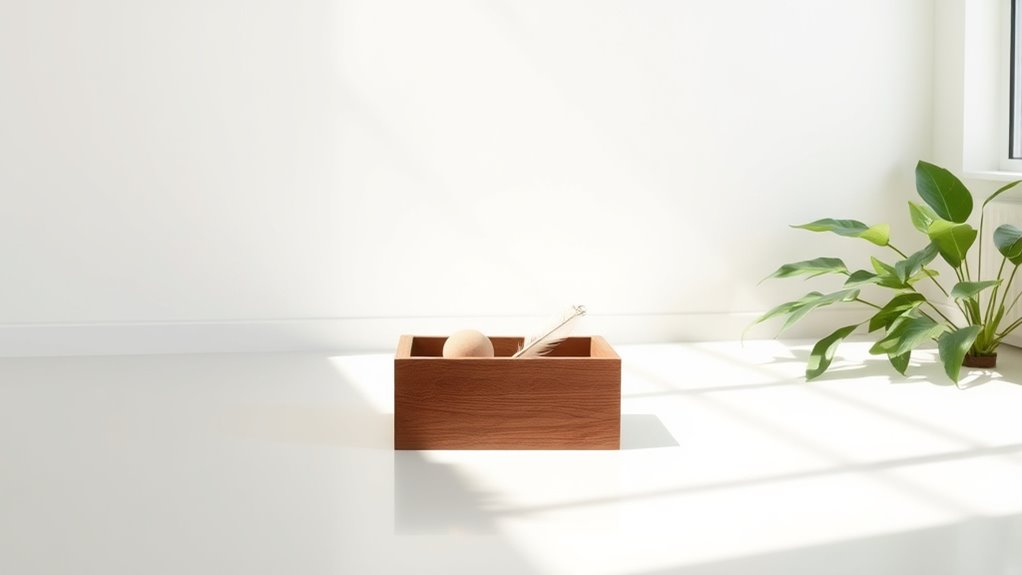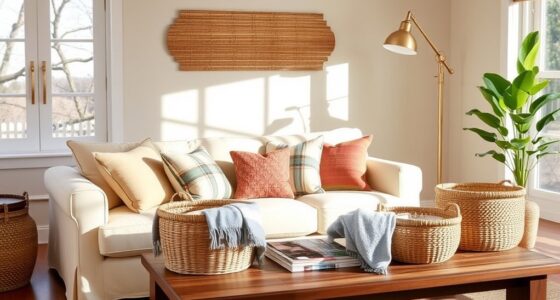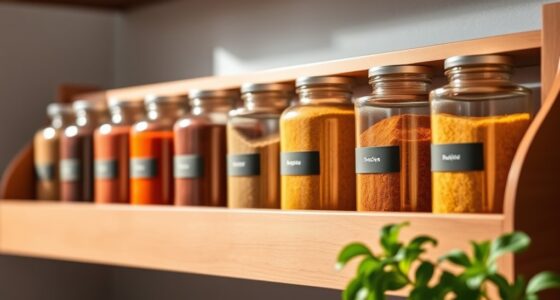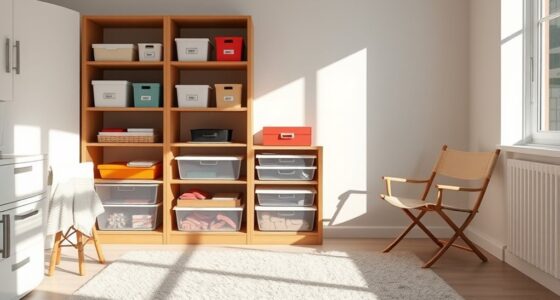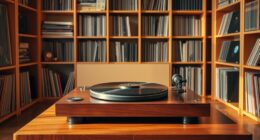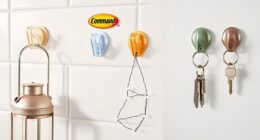The one decluttering tool I swear by for a simpler life is a versatile, multifunctional bag. It helps me streamline organization, making it easier to reduce clutter around my home. With the right bag, I can store items neatly and access them when needed. It's all about functionality and quality, ensuring it lasts for years. Plus, a clean design keeps things aesthetically pleasing. If you're curious about the best features to look for, I've got more insights to share.
Key Takeaways
- Multi-purpose storage bins are favored by minimalists for their versatility in organizing various items efficiently.
- High-quality labels help maintain organization, reducing decision fatigue and promoting a clutter-free environment.
- Lightweight and portable tools facilitate easy movement and decluttering in multiple spaces around the home.
- Eco-friendly materials align with minimalist values, supporting sustainable living while decluttering.
- Aesthetically pleasing designs create a calming atmosphere, making the decluttering process more enjoyable and manageable.
Decluttering Mastery: 3 Books in 1
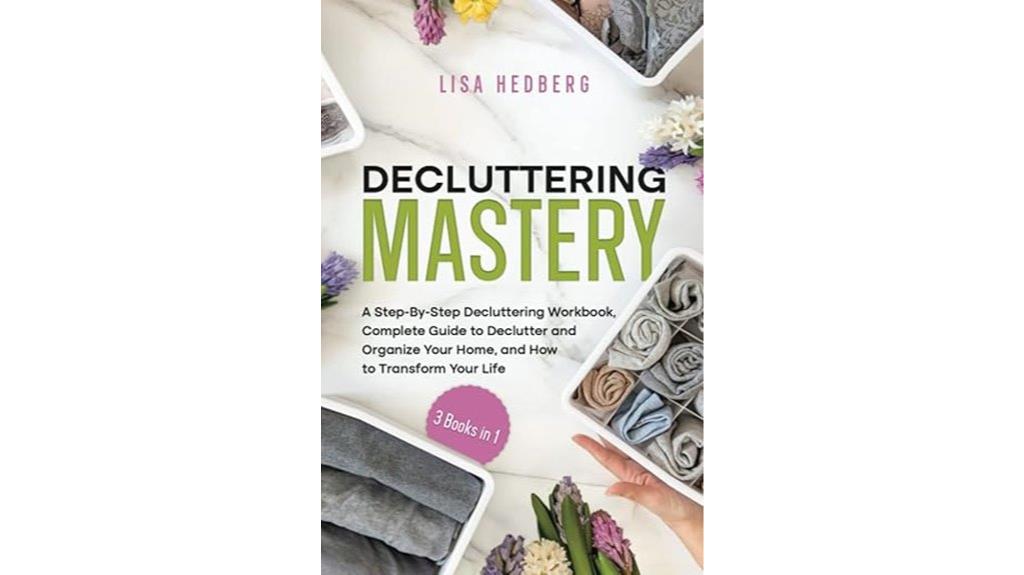
If you're someone feeling overwhelmed by clutter and seeking practical solutions, "Decluttering Mastery: 3 Books in 1" is your go-to resource. This thorough guide helped me regain control over my space and transform my life. It's structured into three parts, making the decluttering process manageable with checklists and actionable steps. I found the motivational aspects incredibly supportive, easing the guilt and overwhelm that often accompany clutter. The practical strategies, like the 20/20 rule and visualization techniques, motivated me to take action. If you're ready for a simpler life, this book could be the breakthrough you need.
Best For: Individuals feeling overwhelmed by clutter who are seeking practical strategies for decluttering and organizing their living spaces.
Pros:
- Engaging writing style that makes the decluttering process manageable and enjoyable.
- Provides numerous actionable strategies and techniques, such as the 20/20 rule and visualization, to motivate and guide readers.
- Includes checklists and structured formats for easy navigation, catering to different areas of the home.
Cons:
- Some readers would prefer visual aids, such as before-and-after photos, to enhance understanding of organized spaces.
- Minor complaints regarding formatting indicate potential for improvement in presentation.
- May not provide enough depth for those seeking advanced decluttering techniques beyond the basics.
Factors to Consider When Choosing The Decluttering Tools Minimalists Swear By
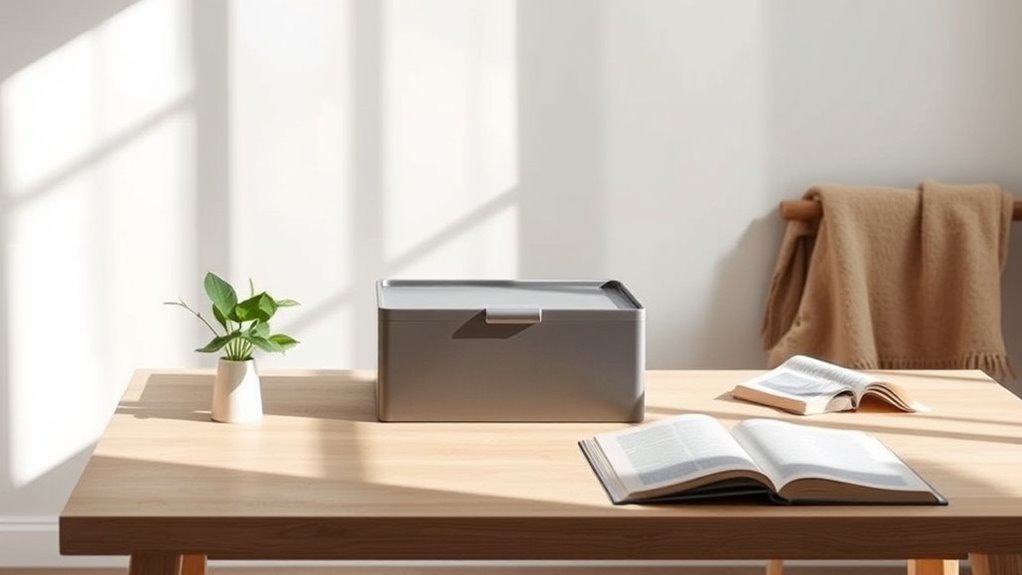
When I'm choosing decluttering tools, I always think about functionality and versatility first. I want something durable and eco-friendly that fits my space and budget. Let's explore these factors together to find what truly works for minimalists like us.
Functionality and Versatility
As I explore the world of decluttering tools, I find that prioritizing functionality and versatility is essential. When I choose tools, I look for those that serve multiple purposes, like storage, organization, and transportation. Versatile tools adapt to various spaces, making them invaluable for both small and large projects. I love tools that easily shift between the kitchen, living room, or garage, as they maximize efficiency and cut down on the need for extra products. Multi-functional tools reduce clutter themselves, aligning perfectly with my minimalist approach. I also assess user-friendly features, like collapsibility or stackability, which enhance practicality and make storage a breeze when I'm not using them. This way, decluttering becomes even simpler and more effective.
Durability and Quality
Choosing the right decluttering tools goes beyond functionality and versatility; durability and quality are key factors that can greatly impact your organizing efforts. When I invest in sturdy tools, I know they'll withstand frequent use, saving me money on replacements. High-quality materials not only enhance the effectiveness of my tools but also guarantee they perform specific tasks efficiently without breaking down. Plus, using durable tools makes the decluttering experience smoother and even enjoyable, leading to successful long-term organization. I've noticed that well-made tools are safer, reducing the risk of accidents during the process. By focusing on durability and quality, I align with minimalist principles, purchasing fewer but more effective and reliable items for intentional living.
Size and Portability
Finding the right size and portability in decluttering tools makes all the difference in my organizing efforts. I've learned that smaller tools are not only easier to store but also more flexible for my busy lifestyle. When I choose portable options, I can declutter on-the-go, which is essential when I'm traveling or juggling a packed schedule. I always consider the dimensions and weight to guarantee my tools fit comfortably in my space without adding clutter. Lightweight and compact tools encourage me to use them consistently since they're easy to handle. Plus, I prefer tools that can be disassembled or folded for even more convenience. This practical approach aligns perfectly with my minimalist lifestyle.
Eco-Friendly Materials
While considering size and portability in my decluttering tools, I can't overlook the importance of eco-friendly materials. Choosing tools made from sustainable materials like bamboo, recycled plastics, or organic cotton minimizes my environmental impact. I love that many of these products are reusable, promoting a circular economy and cutting down on single-use items. Opting for biodegradable materials also means less landfill waste since they break down naturally after disposal. Plus, using non-toxic tools improves indoor air quality, as they have lower levels of volatile organic compounds (VOCs). By supporting eco-friendly brands, I not only contribute to a healthier planet but also encourage more companies to prioritize environmental responsibility in their manufacturing processes.
Cost-Effectiveness
When I evaluate decluttering tools, I always keep cost-effectiveness in mind because it greatly impacts my overall minimalist journey. I consider the long-term savings these tools might provide, like reducing my need for storage solutions or cutting down on items I need to replace. Sometimes, higher-quality tools have a steeper initial cost but last longer, ultimately saving money. I also look for multifunctional tools that serve multiple purposes, which can minimize my spending on single-use items. Additionally, I assess how affordable replacement parts are, as costly upkeep can undermine cost-effectiveness. Finally, I think about resale value; tools that maintain their worth or can be sold after use contribute to a more financially sound decluttering strategy.
Aesthetic Appeal
Aesthetic appeal greatly influences my choice of decluttering tools, as it can transform not just the functionality but also the ambiance of my space. I often seek out tools with clean lines, neutral colors, and simple designs, which create visual harmony and promote a calming environment. When my decluttering tools are aesthetically pleasing, I find it easier to maintain organization; I'm more inclined to keep spaces tidy when I love how they look. I also appreciate high-quality materials and craftsmanship, as they add an elegant touch that complements my minimalist decor. By incorporating multifunctional tools that blend practicality with aesthetic charm, I maximize space efficiency while preserving that uncluttered, serene look I crave.
Ease of Use
Choosing decluttering tools that are easy to use makes the entire process more enjoyable and efficient. I always prioritize intuitive tools that I can grasp quickly without needing lengthy instructions. Ergonomic designs and comfortable grips are essential, especially during those longer decluttering sessions. I also prefer versatile tools; they simplify my space and reduce clutter while serving multiple purposes. Lightweight and portable options are a game changer, allowing me to move them around easily, tackling various rooms with minimal effort. Finally, tools with clear labeling or color-coding streamline organization and help me avoid decision fatigue. With these factors in mind, I can make my decluttering journey smoother and more effective.
Frequently Asked Questions
What Is the Best Way to Start Decluttering?
When I decided to start decluttering, I found it helpful to tackle one small area at a time. I focused on a single drawer or shelf, which made the process less overwhelming. I asked myself if each item was useful or meaningful, and if not, I let it go. Setting a timer for 15 minutes also helped me stay focused. It's amazing how much lighter I felt after just a short session!
How Can I Maintain My Decluttered Space?
Maintaining a decluttered space feels like tending a beautiful garden; it requires care and intention. I've found that setting aside a few minutes each day to assess what I truly need keeps clutter at bay. I make it a habit to question every item before it enters my home. By establishing clear zones for my belongings and committing to regular check-ins, I create a sanctuary that reflects peace and clarity in my life.
Is Minimalism Suitable for Everyone?
I believe minimalism can be suitable for many, but it really depends on personal values and lifestyles. It's not a one-size-fits-all approach. I've found that focusing on what truly matters brings clarity and peace. However, some might feel restricted by it. It's important to explore what works best for you. If you find joy in simplicity, minimalism might resonate with you, but if you prefer abundance, embrace that instead.
Can Decluttering Reduce Stress and Anxiety?
I used to feel overwhelmed by the chaos in my space, and I wondered if decluttering could truly help. Once I started clearing out the clutter, I noticed a remarkable difference in my stress levels. The simplicity of a tidy environment felt liberating. It's as if I could finally breathe again, and my mind became clearer. So yes, decluttering can definitely reduce stress and anxiety—it did wonders for me!
How Often Should I Declutter My Home?
I've found that decluttering my home every few months works best for me. It keeps things manageable and prevents overwhelm. I usually set aside a weekend to tackle one room at a time. However, I also do quick declutters whenever I notice things piling up. If I feel stressed or anxious about my space, I know it's time for a little refresh. Listening to my needs has made all the difference!
Conclusion
To sum up, if you're ready to embrace a simpler life, consider the decluttering tool that minimalists can't live without. It's functional and versatile, durable and eco-friendly, cost-effective and aesthetically pleasing. By choosing the right tool, you'll not only simplify your space but also enhance your well-being. So, let's declutter with intention, let's create a home that inspires, and let's live with less to enjoy more. Your journey to minimalism starts with this one essential tool!
